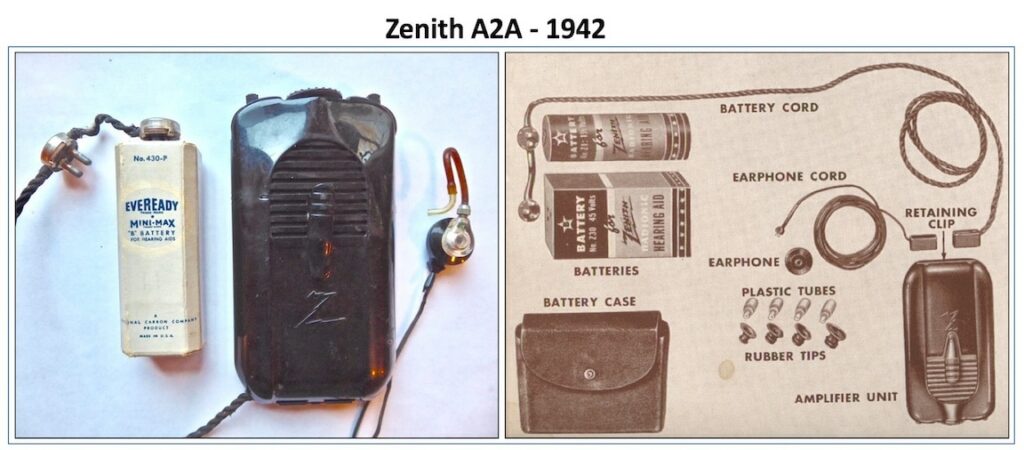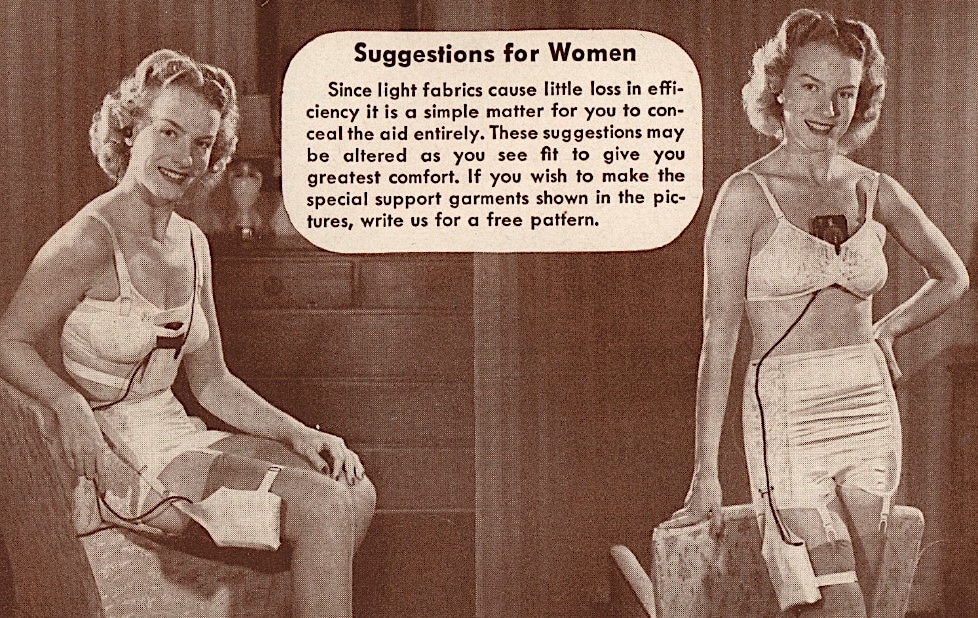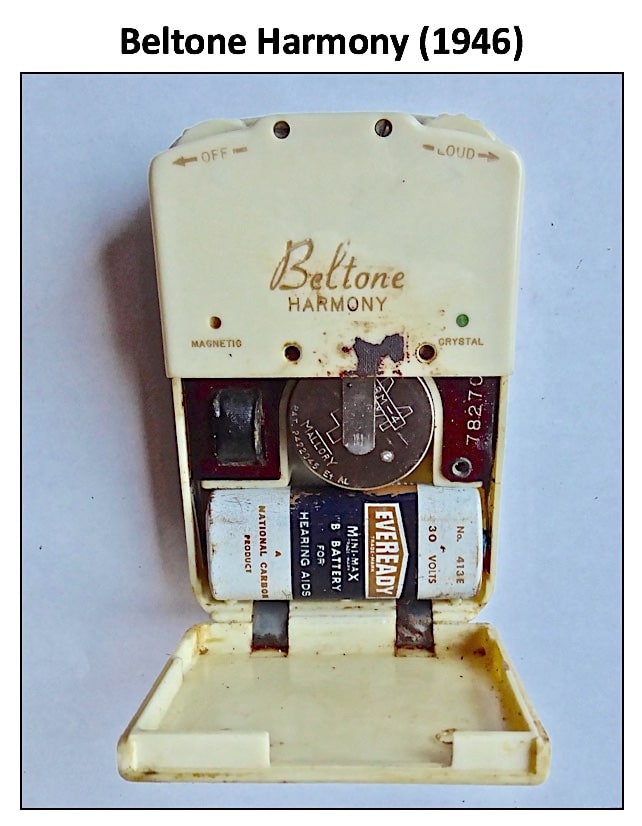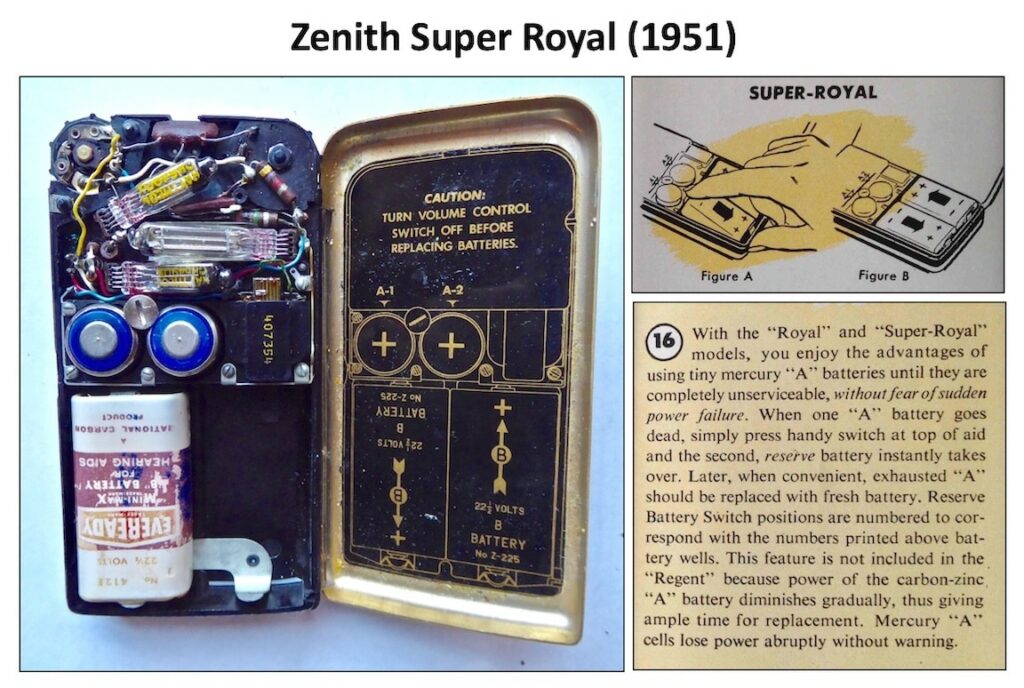Previous posts have talked about early vacuum tube and transistor hearing aids, and the hearing aid batteries they used. A tremendous change occurred in hearing aid size in going from vacuum tubes to transistors as amplifiers. Much of that related to changes in the battery size as well, as previously discussed.
This post is intended to show how some of these batteries actually looked as attached and/or inserted into hearing aids, and how these changes occurred over time, especially during the late 1940s and into the 1950s.
Battery Supply for Vacuum Tube Hearing Aids (1942 Product)
These are generally the images shown in any discussion about the history of hearing aids. This post will not overdo this, but instead show how these power supplies operated with one of the author’s old boxed-up hearing aid collection units.
Zenith A2A
The Zenith A2A was an early two-part hearing aid (Figure 1). Part one consisted of the hearing aid, and part two consisted of the two large batteries required to operate the hearing aid. The batteries were often contained in the same pack (pack shown in the right image in Figure 1 and shown in intended use in Figure 2.

Figure 1. This 2-pack 1942 Zenith A2A hearing aid is a 2 vacuum tube amplifier. It uses a 1.5 volt “A” battery (not shown attached on the left image, but intended to be attached to the two-prong plug), and a 30 volt “B” battery (430-P). The consumer of this aid had obviously replaced the Zenith brand battery with a comparable voltage and same plug arrangement. The hearing aid is one part of the 2-pack system, and the batteries collectively constitute the second part of the 2-pack system. The batteries were most often contained in the same pack. This instrument was called the “Radionic Hearing Aid.” Zenith had its own labeled brand of batteries as seen in the right image, but many different “A” and “B” batteries could be used as long as they had the appropriate plugs and voltages.

Figure 2. Battery pack suggestions for women as provided by Zenith Radio Corporation for its A2A body-worn hearing aid owner’s manual.
Battery Supply for Vacuum Tube Hearing Aids (1946 Product)

Figure 3. Beltone Harmony 3-vacuum tube hearing aid of 1946. This image shows the hearing aid with the round RM-4 “A” battery and a 30 volt “B” battery (in this case the Eveready 413E). This unit used a crystal microphone, as identified by the green dot on the right above the battery opening. The unit measured 108 x 70 x 24 mm.
By 1946, both the vacuum tubes and batteries had been reduced in size, as shown in Figure 3 and were housed in the same package (minus the receiver). This included both the “A” and “B” batteries.
Beltone Harmony (1946)
The Beltone Harmony hearing aid shown in Figure 3 is such a monopac. This vacuum tube hearing aid contained a RM-4 “A” battery and an Eveready 413E “B” battery in the same case as the remainder of the electronics.
Battery Supply for Vacuum Tube Hearing Aids (1947 Product)
By 1947, body-worn hearing aids had made continued improvements in vacuum tube size and lower battery power requirements.
Acousticon A 90M (1947)
Figure 4. The Acousticon A 90M vacuum tube body-worn hearing aid of 1947 was made by Dictagraph Products of New York. This used a RM-4 “A” battery (1.5 V) and a 15 volt “B” battery. Although smaller that most previous body-worn hearing aids, it still measured 105 x 60 x 22 mm in size.
Figure 4 shows the Acousticon A 90M body-worn hearing aid. This hearing aid still used the 1.5-volt RM-4 “A” battery, but the “B” battery voltage had dropped to 15 volts. This hearing aid was slightly smaller in size than the Beltone Harmony of just one year earlier, showing that even small changes in size was a design goal.
Battery Supply for Vacuum Tube Hearing Aids (1950 Product)
Microtone T-10 or Microtone “Ten” (1950)
This was a rechargeable hearing aid using 3 vacuum tubes. It was powered by a RM-1 “A” battery and a 504 “B” battery (Figure 5). It was identified also as “Sealed Power.” This hearing aid had a Sterling Silver case and came with a dresser top storage case that had a battery tester called the “Micro-Mizer.”

Figure 5. Microtone T-10 Sterling Silver hearing aid and its “Micro-Mizer” A/C powered battery tester. The battery tester had two slots for testing and reconditioning the two different hearing aid batteries. Their voltages were measured on the same voltage scale on the meter. It had a scale for the “A” battery and another for the “B” battery. Each was tested separately using a “Test” button on the tester. The range of the “A” battery was from 0 to 2 volts. That for the “B” battery ranged from 0 to 50 volts. The Micro-Mizer was used to place the batteries in overnight to “recondition” following daily use. It was advertised that by doing so, the effective life of the “A” battery could be extended by 3 to 4 times, and the “B” battery up to 5 times its normal life. It was recommended that the user have two sets of batteries so that one set could be “reconditioned” while the other set was being used.
Battery Supply for Vacuum Tube Hearing Aids (1951 Product)
Continued size reduction, but with increased power was a design feature in the early 1950s.
Zenith Super Royal (1951)
A good example is the Zenith Super Royal in 1951 (Figure 6). This was one of the last vacuum tube hearing aids (3 vacuum tubes) made by Zenith, changing to transistorized hearing aids in 1953. This unit was unique in that it used four batteries: two 1.5 volt “A” batteries (Zenith size 222, same size as RM-1), and two 15-volt “B” batteries. Only one of the “A” batteries was in use at any given time, with the user periodically switching between the two “A” batteries (switch on the top of the aid – A1-A2) to provide some recovery while the other was being used. The “B” batteries (22.5 V) were connected in series to produce 45 volts for increased output power.

Figure 6. Zenith Super Royal 3 vacuum tube hearing aid of 1951. This hearing aid was unique in that it used four batteries. It had two “A” 1.5 volt batteries and two 22.5 volt “B” batteries, which were wired in series to produce 45 volts for added output power. It measured 113 x 59 x 22 mm in size. This shows the two RM-1 batteries in place, but only one of the 22.5 volt batteries.
The next post will describe some battery products for early transistor hearing aids.







Fascinating history. I have worn aid since 1970, now dissapointed with digital types, processing ONLY to reduce feedback ( Cant get decent ear molds anymore ), audio artefacts generated as coefficients update as device’adapts’.
World is full of warning ‘beeps’ thesedays ! . Hearing aid design is now based on Fashion viz unobtrusive etc and Limits SPL. Recently tried bone conduction Bluetooth headset – Quality great volume adequate but Bluetooth latency makes it useless for conversation – made up body worn style amp to drive bone conductor via cord and use lapel worn microphone- result is bliss. Question is,where can I buy one instead of using up my time ? NB I am profession (retired) electronics design eng.
I am inspired by your work and got some great ideas. Thanks and keep sharing 🙂